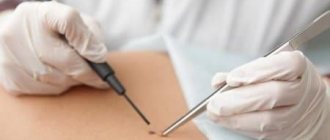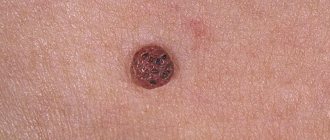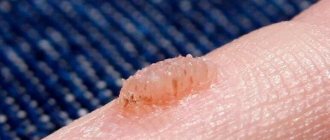Papillomas in intimate places are external manifestations of papillomatosis, which is of viral origin and is caused by the human papillomavirus (HPV). They appear on any part of the body, including mucous membranes. Papillomas appear very often in intimate places and are always transmitted sexually. Papillomatosis can occur regardless of a person’s age and gender.
PVI, or human papillomavirus infection, is widespread, and today 300 million people in the world suffer from it; in Russia - a third of the population. The rates are especially high among active young people aged 18–19 years. Most often, papilloma is known as a wart, which protrudes slightly above the skin level and which can easily be accidentally injured by clothing, nails, or shoes. Then it becomes inflamed and bleeds.
Most papillomas are benign formations, but some of them are dangerous. On the genitals they are pinkish-flesh in color, and their shapes may vary. To date, more than 100 types of virus have been identified, 40 of which are associated with damage to the urogenital organs. Only 5 of them have a low oncogenic risk, which means that the risk of degeneration of formations in intimate places is quite high. Therefore, it is necessary to know more about them.
Is it possible and how to get rid of papillomas? Unfortunately, when the papillomavirus is introduced into the body, it remains there forever, despite any treatment, and the person becomes its carrier for life. But the manifestations of PVI largely depend on the person himself.
Causes of papillomas in intimate places
Papillomatosis or human papillomavirus can be hidden for a long time. The main impetus for its development can be a significant decrease in the body’s immune forces.
The following reasons influence the awakening of the virus:
- hormonal disruptions in the body in women after pregnancy or as a result of long-term use of hormonal contraceptives;
- bad habits – smoking, alcohol abuse, drug addiction;
- colds of an infectious nature;
- long-term treatment with antibiotics, immunosuppressants, corticosteroids;
- venereal pathologies, herpes infection, inflammation in the genitourinary system;
- constant stress, emotional tension, chronic fatigue;
- disruptions in metabolic processes.
A long-term cold can awaken HPV
The listed factors lead to immunodeficiency, which is a favorable environment for the awakening of papillomavirus.
Are papillomas in intimate places contagious?
The main feature of papillomas on the genitals is their high level of variability. You can catch the disease, which will later manifest itself on the genitals, through sex with an infected partner, as well as through contact and household contact (through bed linen, towels).
Causes
The reasons for the appearance of PVI, of course, are the entry and development of the virus. Factors provoking its appearance:
- STIs, frequent changes of partners and promiscuity;
- violations of the vaginal microflora;
- pregnancy;
- hypovitaminosis;
- unprotected sexual contact - even 1 contact with a virus carrier gives a 60% risk of infection (with unprotected sex, the risk of a woman getting infected from a man is much higher);
- the risk of infection increases in the presence of chronic inflammatory diseases of the genitourinary system;
- chronic stress;
- hormonal imbalances;
- chemotherapy;
- immunodeficiency states;
- poor nutrition;
- overwork;
- diets;
- long-term use of antibiotics;
- basic lack of intimate hygiene.
The human papillomavirus, when it enters the intimate zone, causes the epithelial cells of the basal layer of the skin to actively divide and grow, resulting in the appearance of growths. Gradually they increase in size. Papillomavirus can infect partners during any form of intercourse. Among them are oral and anal sex, friction of the genitals against the partner’s organs.
Infection occurs in the presence of any microtraumas on the surface of the skin or mucous membranes, and almost any person always has them, for example, after shaving. Without an entry gate, HPV cannot penetrate the skin, and the skin in the bikini area is very vulnerable due to its thinness. The most common viral strains among anogenital warts are 6, 11, 16, 18. The last 2 types have a high oncogenic risk, and they cause cervical cancer. Condoms do not protect you completely from the risk of infection, but only by 50%. Therefore, you need to take care of strengthening your immunity.
Symptoms in women and men
The main symptom of papillomatosis is the appearance of growths in the groin, which look like loose lobules collected in piles, reminiscent of a broccoli inflorescence or a rooster's comb.
Locations:
- in men - on the scrotum, around the head of the penis, near the urination channel, in the folds between the legs;
- in women - on the vulva (on the labia majora and minora, in the vagina, on the pubic part), in the cervix;
- independence from gender - on the skin in the perineum between the genitals and anus, around the anus and inside the anus (rarely).
The glans penis affected by papillomas
Warts on the genitals are brownish or beige in color. If their integrity is violated (sexual intercourse), they can cause pain and discomfort, and bleeding.
Types of papillomas in the intimate area
Inguinal growths have their own differences and types:
- Filiform papillomas. At the beginning of development, small yellowish bumps appear, which over time develop into elastic thread-like formations.
- Flat papillomas. Rounded small bumps that blend in color with the skin. They are rare, but can cause inflammation in the genitals, itching, burning, and pain.
- Condylomas (pointed). Elastic growths look like a large number of small lobules fused together.
- Papillomas of the bladder and urethra. It mainly affects men.
On the female organs, or rather inside them, genital warts most often develop. You can see them during a gynecological examination.
What types of papillomas there are in intimate places and what they look like is shown in the photo.
Papillomas of the filamentous variety
Flat type of papilloma
Acute condylomas
What tests are required?
Complex of examinations
includes:
• Smear of urethral discharge in men and vaginal discharge in women for STIs (sexually transmitted infections). • Smear for atypia of cervical cells. • Testing for HPV (human papillomavirus). • Blood testing for HPV using PCR. • General blood and urine analysis. • Blood for hepatitis B and C, HIV infection and syphilis using ELISA.
Based on the examination results, the doctor will decide on treatment tactics.
Are papillomas dangerous?
Papillomas of any type can pose a hidden danger.
- If the growth is injured, it begins to spread to healthy areas, which leads to the growth of unpleasant formations.
- Infection can penetrate into damaged papilloma tissue, which threatens the development of inflammation of the groin area.
- There is a high tendency of papilloma to enter the oncogenic stage, especially those that affect the woman’s cervix.
Papillomas in the intimate area can develop into cancer
Important! Very rarely, papillomas develop into cancer among males, but they can provoke other serious pathologies of the genitourinary system (phimosis, paraphimosis).
Use of medications
If there is absolutely no way to be treated using modern non-invasive methods, you can try to remove condylomas using chemical medications.
Cauterization of lesions with chemicals can be done at home, but the method does not guarantee getting rid of genital papillomas. Moreover, self-treatment can lead to chemical burns, trauma and further spread of the pathological process.
In addition, the procedure for applying aggressive chemicals is painful, especially after the first use, and given that the mucous membranes of the genital organs are “delicate” tissues, the use of cauterizing drugs is not the best choice.
Treatment of genital papillomas should be carried out by a competent specialist who can recommend a treatment method that is suitable for you.
When HPV infection is confirmed, surgical intervention alone is not enough, since the proliferation of condylomas on the genitals is a consequence of a pathological process, and the cause is a disruption of the immune system. Therefore, it is additionally necessary to take immunomodulators and immunostimulants.
In case of particularly active processes of growth of pathological formations on the genital organs, in the groin, it is necessary to visit an oncologist to exclude the diagnosis of malignant changes in the skin.
Treatment methods
Papillomavirus cannot be removed from the body, but it is quite possible to put it into a dormant state.
The following methods allow you to do this:
- removal of papilloma;
- drug treatment;
- use of folk remedies.
Therapy for papillomatosis should be comprehensive and combine several methods at once.
Removal of papilloma on the genitals
Timely detected papillomas respond well to treatment and do not have time to harm a person. You cannot try to eliminate such a problem on your own, otherwise you can provoke serious complications.
Which doctor removes it?
If you identify suspicious formations on the genitals, you should contact a dermatologist or venereologist. In situations where the warts have become large and darkened, it makes sense to consult an oncologist.
A venereologist will help you get rid of papillomas in an intimate place
The specialist helps get rid of unwanted growths and provides special treatment aimed at preventing relapses.
Should I delete it?
In the early stages of papillomatosis, warts do not cause any discomfort, so doctors may prescribe drug treatment. When the growths are large, often injured, bleed and hurt, and inflammation develops in the genitals due to the addition of other infections, the papillomas must be removed. This will help prevent cancer.
Does it hurt to remove?
Excision of warts occurs under anesthetic. Depending on the procedure, unpleasant sensations are possible: burning, tingling, tingling, slight pain. Most often, papillomas are removed painlessly.
Modern removal methods and their costs
Elimination of papillomas in intimate places can be carried out using several methods. How much removal costs depends on the size of the warts and the type of procedure.
- Surgical method - the growths are excised with a scalpel, and the area is treated with a special solution and tightly bandaged. The manipulation takes place under local anesthesia. Price – from 450 to 1500 rubles.
- Electrocoagulation. Papillomas are cauterized with high-frequency current. As a result of this procedure, irreversible processes occur inside the growths and they disappear. Price – from 400 to 800 rubles.
- Cryodestruction - removal with liquid nitrogen - allows you to painlessly eliminate the tumor. The affected areas are treated with liquid nitrogen, which provokes darkening, drying and death of papillomas. Cost – from 300 to 600 rubles.
- Radio wave removal. Warts are cut off using a radio wave scalpel, which acts exclusively on the affected tissue, does not affect the healthy epidermis and does not leave scars. Price – from 500 to 1000 rubles.
- Laser treatment is the most popular and effective way to combat papillomas. In addition to cutting off the growth, the laser beam gently cauterizes capillaries and injured areas, which helps prevent inflammatory processes, bleeding, and scars. Price – from 650 to 1600 rubles.
- Cauterization with chemicals. To remove flat growths and condylomas, the drugs podofilin and podofilox are used. After treating the affected areas, crusts remain, which disappear on their own after 2-3 days.
Laser removal is the easiest and most popular method
Removal of papilloma should occur only after a complete examination, which excludes the malignant nature of the formations. Otherwise, serious complications can occur.
Drug treatment
Doctors try to treat minor lesions of the genitals by papillomas with pharmaceutical preparations for internal and external use.
The medicine Panavir helps remove growths and prevent relapses of human papillomavirus infection. The product is available in the form of an injection solution and gel, which allows it to act on the virus from the inside and outside.
A good antiviral drug is Viferon (suppositories, gel, ointment). The medicine not only suppresses the development of infection, but also stimulates the body's immune forces.
Viferon is an effective antiviral drug
Another effective remedy against papillomas is Oxolinic ointment. The substance has a detrimental effect on the infection, inhibiting its reproduction.
Acyclovir tablets and cream have a high antiviral effect. The product stimulates the body's protective barrier well and suppresses infection.
To achieve the maximum therapeutic effect, the doctor can prescribe several drugs for local and systemic use. Your approach allows you to achieve long-term remissions of the disease.
How to get rid of it using folk remedies
How to treat papillomavirus infection at home? For this purpose, folk medicine has effective and proven recipes.
Castor oil
For 2-3 weeks, injured areas must be treated with castor oil. For best results, the oil should be gently rubbed into the growths for 7–10 minutes. The frequency of procedures is several manipulations per week.
Castor oil is a good remedy for getting rid of papillomas at home
Celandine juice
It is recommended to wipe viral growths on the genitals with a small amount of the substance. Manipulations are done up to 4–5 times a day. Duration of treatment is 1–1.5 months. It is important not to touch healthy areas so as not to provoke a burn.
When applying the juice, it is important not to touch healthy areas of the skin.
Iodine for papillomas on the genitals
Wipe the benign tumor daily with iodine solution. The antiseptic substance not only dries, but also disinfects, which stops the development of infection.
Iodine stops the development of infection
It must be remembered that folk remedies cannot overcome the disease on their own. They should be used in complex drug therapy prescribed by a doctor.
How does the papillomas removal procedure take place?
Before the procedure begins, the skin and mucous membrane of the genitals are treated with 10% Lidocaine spray or another anesthetic, for example, Ubestezin, which allows you to not feel pain during the procedure.
Destruction of papillomas in the intimate area with a laser is one of the popular methods of therapy. The procedure takes no more than 10 minutes; the laser beam acts on the vessels feeding the formation, causing their destruction through evaporation (vaporization). Within a few days, the papilloma dries up and disappears. After 2 weeks, the skin is completely clear of the crust, and the wound is epithelialized.
How many therapy sessions are required depends on the size of the tumor. For a small size, as a rule, 1 laser session on the papilloma is sufficient; for a large, long-standing papilloma, 4-5 manipulations may be needed.
Laser therapy as a method in the treatment of papillomas on the genital organs has a number of advantages:
Laser surgery is virtually painless after minor local anesthesia.
Due to the special effect of the laser on the vessels, there is no bleeding.
The laser beam has tissue healing properties.
The use of laser helps to avoid the formation of scars and scars.
Short recovery period.
Due to the ability to select the desired properties of the laser beam, the depth of exposure can be controlled. without damaging healthy tissue.
The laser has a disinfecting effect, which eliminates secondary infection during surgery.
Treatment during pregnancy
Papillomas in the intimate area can grow greatly during pregnancy and subsequently interfere with childbirth. To avoid this, doctors prescribe laser excision of growths and treatment with antiviral substances. During pregnancy, Viferon and Betadine are allowed to be used.
Papillomavirus detected during pregnancy must be treated without fail, as it threatens to infect the fetus (most often during the child’s passage through the birth canal) and cause the baby’s nasopharynx and larynx to be affected by condylomas.
Papillomas on the genitals are an unpleasant and very dangerous phenomenon, since if left untreated for a long time, there is a high probability of developing cancer. Therefore, it is important not to hesitate to consult a doctor if suspicious growths are found in the groin.
Alternative methods for removing papillomas
Cryodestruction
Condylomas can be removed using cryodestruction. The essence of the method is to influence the neoplasm with liquid nitrogen.
The cryodestruction procedure is allowed to be used in pregnant women and children.
The procedure for cryodestruction is carried out with a special device, during which papilloma tissue is destroyed layer by layer.
To destroy papilloma on the genitals, as a rule, 1 procedure is required.
Cryodestruction is capable of destroying tumors of varying depths; there is no bleeding or pain during manipulation.
Cryodestruction is successfully used to treat genital warts.
Application of an electric knife
Electrical destruction is carried out using an electric knife, to which a current of various frequencies is supplied.
Depending on the nature of the growth, the doctor decides which current is best for treatment. High frequency current is used to remove condylomas.
The disadvantages of the method include the risk of possible re-development of the formation and the need for anesthesia, since the procedure for electrical destruction of condylomas is quite painful for the patient.
With electrical destruction, the postoperative scar takes longer to heal, which increases the recovery period.
The use of this method of therapy is considered somewhat outdated, but continues to be used in a number of clinics.
Radiotherapy
A good therapeutic effect for the removal of genital warts is provided by the use of a special Surgitron device. The principle of operation is similar to the use of a laser beam.
The most modern method that allows you to get rid of growths quickly and painlessly. It is possible to treat all papillomas in one session, regardless of size. There are practically no scar changes left on the skin.
All of the above methods are, as a rule, paid and are used for the treatment of tumors in commercial clinics. If for some reason modern treatment is not possible, open surgical removal of condylomas is used. Under local anesthesia, the tumor is excised using a scalpel.
Of the minuses
:
increased trauma, pain, postoperative scar.
But we draw your attention to the fact that for neoplasms of unknown origin, the open method of surgical treatment is preferable, since it allows for histological examination after a biopsy. The cells of the tumor-like formation are not destroyed, which is important for establishing the correct diagnosis.
The surgical open method of treatment allows you to get rid of tumor-like formations of any size.
Drugs for the treatment of papillomas
Need advice from an experienced doctor?
Get a doctor's consultation online. Ask your question right now.
Ask a free question
There is no drug therapy with a proven effect for papillomatosis on the genitals. In practice, antiviral drugs and immunostimulants are used. The goal of treatment is to activate the body's own reserves to fight the virus. Drug therapy is prescribed by a doctor based on the patient’s age, diagnosis, and medical history. The presence of chronic diseases is taken into account. Self-administration of drugs such as Acyclovir or Oxolinic ointment from a pharmacy for condylomatosis is inappropriate.
Antiviral and immunostimulating
The list of antiviral drugs prescribed for HPV infection is small. What the doctor will suggest:
- isoprinosine – 2 tablets 3 times a day;
- groprinosin – 2 pcs. 3–4 times a day;
- Viferon - suppositories for rectal administration;
- cycloferon;
- allokin-Alpha;
- interferon.
All medications promote the production of its own interferon, which allows the body to independently cope with the virus and growths in intimate places.
Local treatment
Ointments, gels and sprays are used to treat papillomas. Popular drugs are Epigen spray and Viferon ointment. The drugs increase local immunity in the intimate area and help suppress HPV. But it will not be possible to remove the formed formations with their help.
Traditional methods suggest treating vegetation with the following aggressive substances:
- grated soap and diluted in water;
- iodine;
- soda;
- garlic;
- celandine juice;
- cauterize with potassium permanganate.
The use of such home treatments can lead to tissue burns, wounds and erosions. They do not act on the cause of the disease - HPV.
The need for proper wound care
After the vegetation is removed, extensive wound surfaces are formed. The method of caring for the reproductive organs should be clarified with the gynecologist or surgeon who performed the procedure.
Standard recommendations:
- accuracy;
- minimal contact with hands, towels, pads;
- compliance with hygiene requirements;
- lack of sexual activity during the rehabilitation period – up to 1 month;
- Treatment with antiseptic solutions is allowed: Tantum Rose.
The use of antibiotics, healing ointments, and other antiseptics is indicated only as prescribed by a doctor.
Features of cauterization
Cauterization of condylomas is carried out in 2 ways. The first is diathermoelectrodestruction of formations using high-frequency currents. The second is the use of aggressive liquids: Feresol, Solcoderm ointment, Superchistotel solution.
Diathermoelectrocoagulation of papillomas is carried out in a medical institution. The doctor places a loop of electrode on the vegetation, passes a high-frequency current, then cuts off the condyloma. After which the location of the benign tumor is cauterized with a ball-shaped electrode. In the area of the vulva and anus, the procedure is performed under local anesthesia.
The disadvantage of this method is that it is highly traumatic, and there is a risk of deep burns at the location of the formation, in the adjacent area.
It is not recommended to use the method during pregnancy to remove condylomas on the vaginal walls.
Treatment of papillomas with aggressive liquids is usually practiced at home. Currently, doctors do not use such methods to treat vegetations on the reproductive organs. The use of such agents is accompanied by chemical burns of nearby tissues and the formation of erosions - long-term non-healing wound surfaces.
The use of aggressive drugs to cauterize papillomas in intimate places is prohibited during pregnancy and when treating children.











